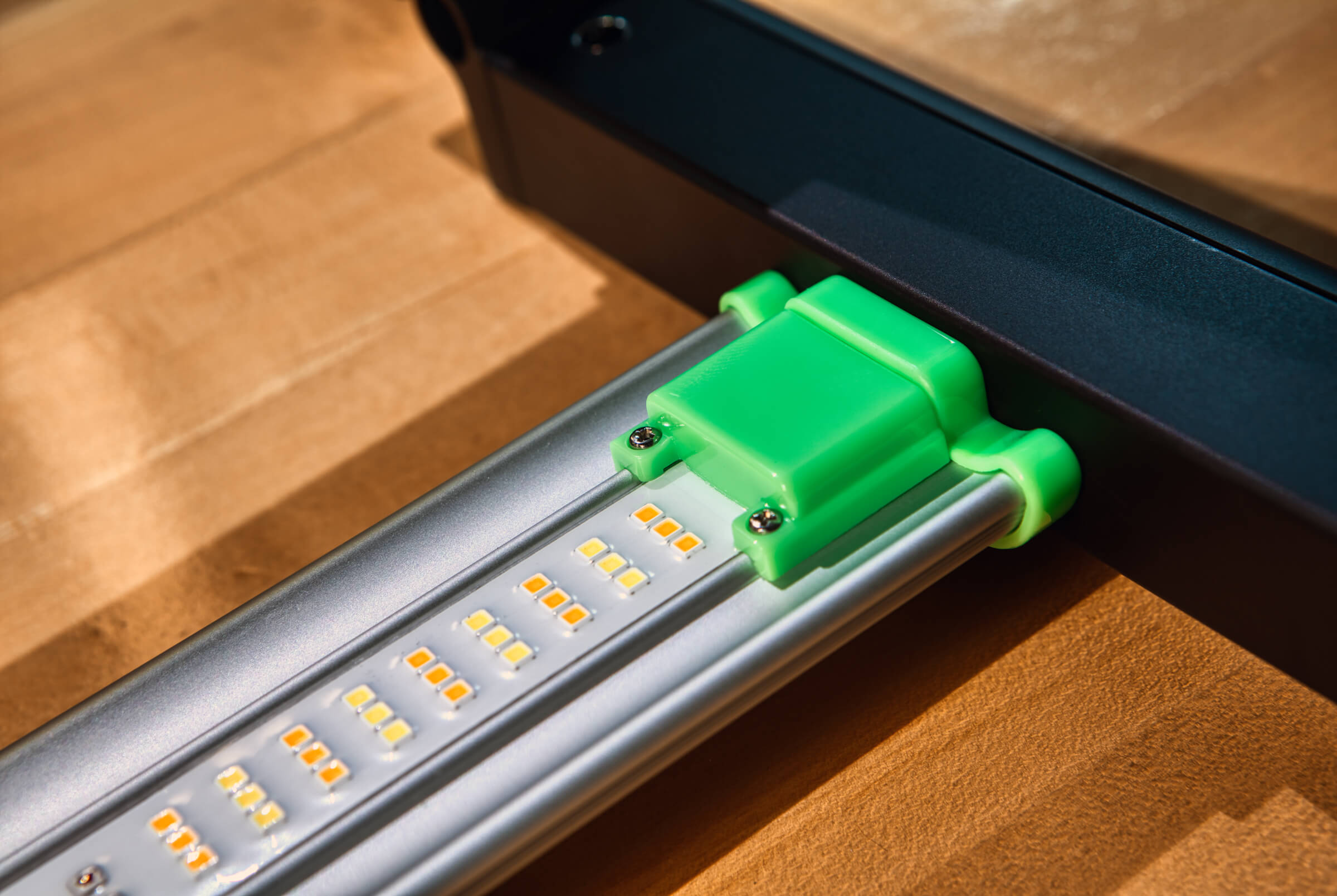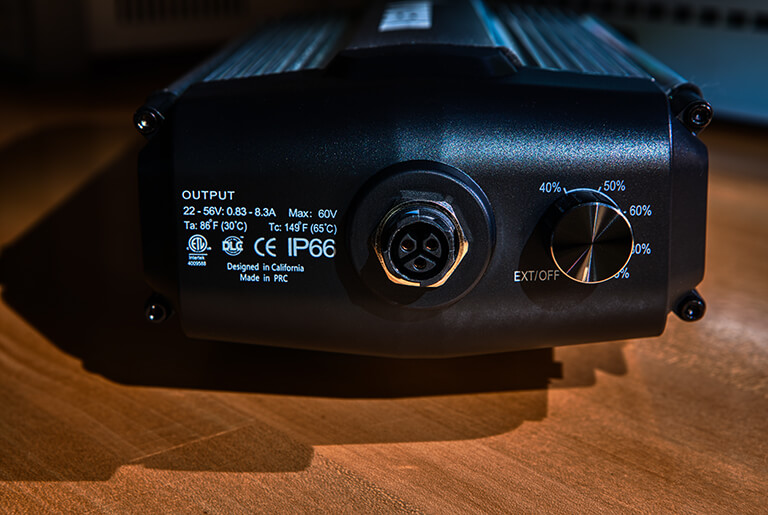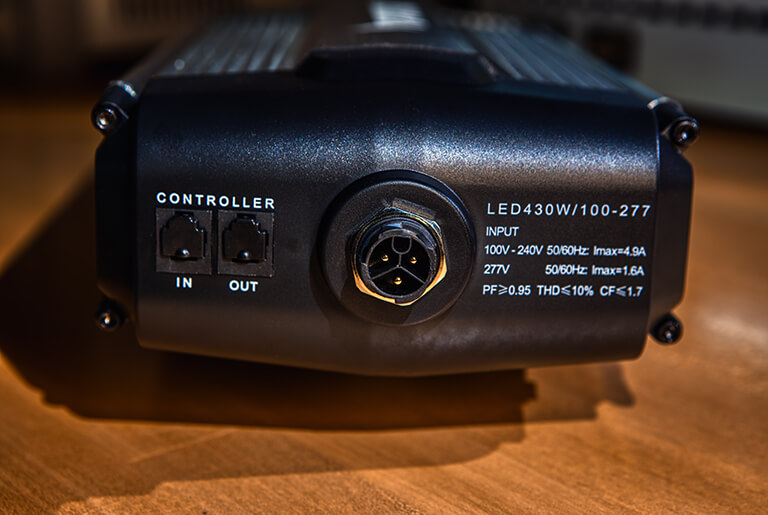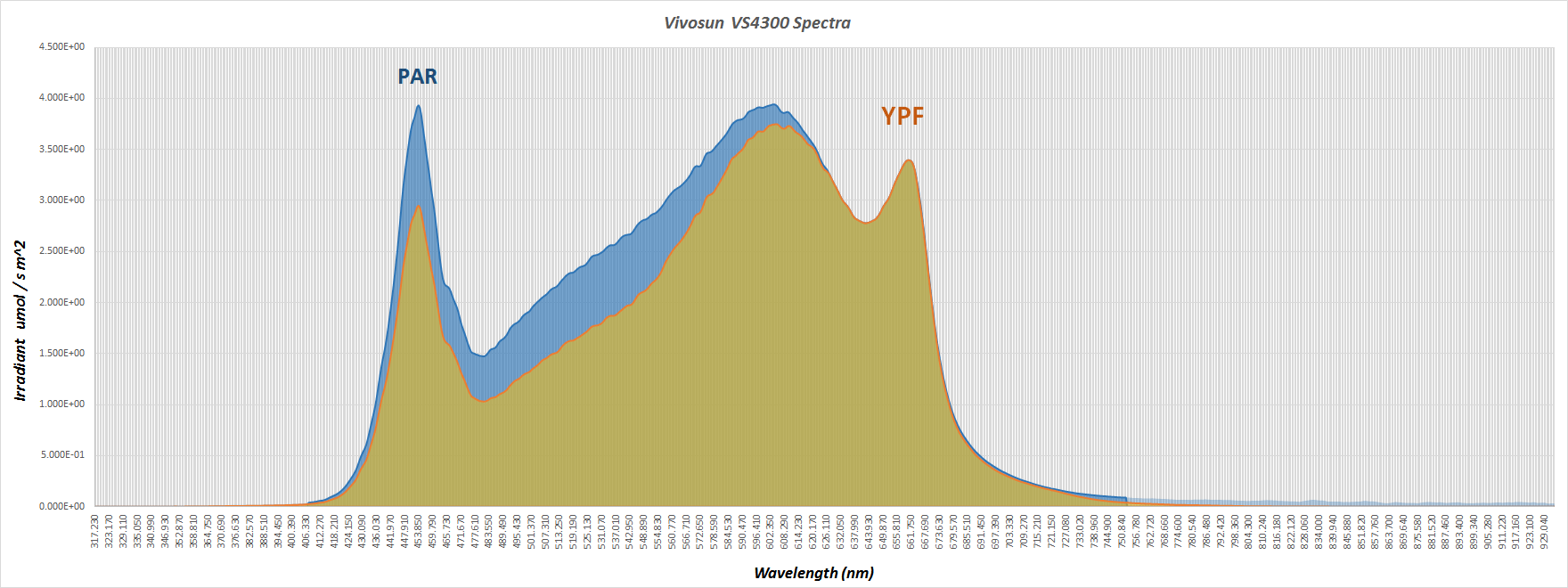Table of Contents
Let’s take a look at VIVOSUN VS4300 LED Fixture. This review is divided into the following sections:
- Introduction
- Shipping and Delivery
- Specifications (OEM specification claims)
- Construction
- Our Measurements
- Discussion (comparing the supplied specification and marketing to our measurements)
Introduction

Shipping and Delivery
The fixtures we have received were overwrapped with a second box to help maintain the integrity of the inner box that actually contains the fixture. Because, you know, the postal service can be gorillas at times.
Needless to say, the overwrap did its job and the fixtures arrived perfectly intact and ready for action.

Package Contents:

Power Supply, a fixture in its folded configuration, cables, user guide, and some miscellaneous configuration sundries.
Specifications
The following are the manufacturer’s specifications for the VIVOSUN VS4300 and included user’s manual:
Dimensions and Weight
Length: 50.13 inches (127.3 cm)
Width: 27.6 inches (70.1 cm)
Width: 2.63 inches (6.7 cm) without power supply
Weight: 24 LBS.
AC Power Consumption
Power consumption @ 120VAC : 3.58A
Power consumption @ 208VAC : 2.07A
Power consumption @ 244VAC : 1.79A
Power consumption @ 277VAC : 1.55A
Operating Environment
Temperature: 95°F (35°C) maximum
Orientation: LED emission facing down
Spectrum

Lifetime
LED expected output : L90: 54,000 hours
Warranty: 5 years
Construction
Mechanical
This fixture has a large mechanical footprint with a lighting area designed to fit within a 4ft x 2ft area.
Traditionally, I’m more familiar with the smaller, more modular fixtures and simply ran out of space to capture a full profile with the camera. It’s pretty big when unfolded relative to what I’m typically using. So, it’s taken me some adjustment to handle this thing without bashing myself in the head or knocking over my coffee. But it’s also clean, compact, and very much suitable for top-lighting style applications with a profile that’s compatible with “standardized” citizen grow-op.
The fixture arrived folded into a clamshell arrangement thanks to 180-degree articulating hinges.

You’d simply fold open the two halves to access the full array of LEDs:
Due to the hinge, I could see some adventurous souls utilizing this for side-lighting projects and wrapping their plants with a couple of these, as well. Hey, why not? A very intense side lighting, that is.
There are a total of four LED slats, or bars, equally spaced and fixed into place across the 4 by 2-foot frame. The distance between the individual bars is not adjustable and permanently affixed. This is somewhat sensible in that the control of the lighting spread and PPFD becomes a known quantity based on the optical engineering of the unit. What you do get out of fixtures that consume a large area with spread-out LED elements is an even and consistent PPFD over the intended area.

Each bar is composed of an aluminum reflector shroud that also serves as a heatsink. This unit is passively cooled meaning there are no fans included to contribute to noise. Passively cooled fixtures will also add heat to the space during operation. As with all passively cooled equipment, it is suggested that some amount of airflow exist to help move heat away from the fixture and to protect the LED componentry from excessive temperatures, and to also consider heat rise when designing for an enclosed area.
Each LED PCB strip array contains 357 yellow/blue white LEDs along with 14 evenly spaced far red LEDs mounted to each slat for a total of 371 LEDs. Across all four bars, this amounts to a total of 1484 individual discrete LEDs for this fixture.
Weather / Ingress protection / IP Rating
The VIVOSUN VS4300 is IP66 rated. What this denotes is that the assembly has been tested for protection against and to safely operate in a specific environment. The two-digit number “66” indicates the level of protection and follows the following format:
This is a nice feature potentially making this model useful in environments with hired personnel and greenhouse-like conditions. The home hobbyist and DIY’er may scoff at this feature as being useless to them while others that have an eye towards safety will find this feature comforting against the occasional misdirected water spray.
Liquid Resistant Fittings
Throughout the design, Vivosun has chosen to employ liquid-resistant electrical fitting and gaskets in areas sensitive to moisture intrusion.
Power Supply

Nearly 12 LBS in weight comprising an aluminum case wrapped in black plastic accents.
Dimming

The VIVOSUN VS4300 has a built-in dimmer switch that allows the fixture to be manually dimmed in several increments from 100% to 40% of full output power. In addition, you can set the dimmer switch to external such that an appropriate external dimmer or control system can control the dimming via the rj-11 connectors.
Further, if you have more than one fixture, these can be daisy-chained together by using the rj-11 style output connector for unified dimmer control.


Connectors
The included power input and output connectors utilize keyed and locking quick-connect style connectors.

LED PWB Construction
Conformal Coating
The PCB on each bar is conformally coated with a translucent siloxane-type rubber. A number of OEMs have been applying conformal coatings on their PCBs over the last several years. An excellent development for protecting sensitive electronics. Vivosun did not skimp on this detail.
A conformal coat protects the LEDs and electronics from moisture intrusion and abrasion. The edges of the PCB laminate, however, do not appear to have a similar coating. In essence, this coating provides strong protection against the errant water spray but avoids submersing the fixture for any length of time. Yeah, I don’t know, I’m sure someone has tried it at one point.

Color Palette
The Vivosun VS4300 utilizes three different LED phosphors, white/blue, white/yellow, and far-red. There are no UV specific LEDs on this fixture:
White/Blue

White/Yellow

Far-Red

Ok, let’s power her on and turn a look-see:

Measurements
AC Power Consumption (no dimming)
Measurement Instrument: Fluke 43B Power Quality Analyzer
Measurement Instrument: Pico TA189 Current Probe
Power Consumption Details
DC Power Consumption (no dimming)
Measurement Instrument: Fluke 43B Power Quality Analyzer
Measurement Instrument: Pico TA189 Current Probe
DC Voltage and Current Draw
Power Consumption
Calculated Supply Conversion Efficiency: Not measured
Temperature (no dimming)
Measurement Instrument: Flir A65 Thermal Camera (click for details)
Operating Temperature
Thermal Image of Operating Assembly LEDs (click to expand)
Thermal Image of Power Supply Assembly (click to expand)
Lighting Metrics
Spectral Power Distribution (SPD)
Measurement Instrument: Stellarnet CXR-SR-100
18 inches from a fixture, open air, center spot, 30 minutes to stabilize
Blue(400 – 500nm) : 21.31%
Green(500 – 600nm) : 42.32%
Red(600 – 700nm) : 36.37%
Total:100%
UVB(287-320nm) : 0.01%
UVA(320-400nm) : 0.13%
Violet_Blue(400-475nm) : 15.21%
Cyan_Green(475-550nm) : 22.69%
Green_Yellow_Red(550-700nm) : 59.78%
FarRed_NearIR(700-850nm) : 2.19%
Total:100%
Spectrum Plots
Captured Spectrum

PAR / YPF overlay

Radiant Energy and Ratios
The following metrics detail the measured radiant energy 18 inches from the fixture, open-air (no nearby reflective walls), and center spot (at the center of the fixture), after allowing at least 30 minutes for the fixture to stabilize:
Integral radiant (400-700nm): 179.9 W/m2
Integral radiant (350-840nm): 183.0 W/m2
Lumens (m^2): 54821
Spectrometer PFD (400-700nm): 837.75 umol / m2 / s
Spectrometer PFD (350-840nm): 856.39 umol / m2 / s
Quantum Sensor PFD (400-700nm): 844.7 umol / m2 / s
YPF (360-760nm) : 728.5 umol / m2 / s
YPF/PFD: 0.87
PSS: 0.85
DLI index [12 hours] PAR: 36.2
Note: The traditional PAR range is defined as being 400nm-700nm.
These types of units are intended for close-in use and, as such, is specified for a recommended minimum height above canopy at 6 inches. I find this to be absurdly close but for those who do so:
Spectrometer PFD (400-700nm): 1280.9 umol / m2 / s @ 6 inches.
Quantum Sensor PFD (400-700nm): 1288.6 mol / m2 / s @ 6 inches.
Output Stability
Output power as measured with the Apogee Quantum Sensor over an ~140-minute period from power-up shows a small amount of variation of ~3% as the unit heats up. Measured 18 inches from a fixture, open air, center-point.
Variation
Output Stability Plot: Delta 910 to 887 umol / m2 / s PAR @ 18 inches. Ambient temperature 71.4°F (21.9°C).

Color Quality
The following details how the human eye will perceive colors that are illuminated by the fixture. This has little to do with the quality of light as perceived by the plant but rather how easy it is for humans to discern colors or how accurate the colors in a photograph under illumination will appear.
Chromaticity 3319K
CCT: 3319K
Chromaticity Coordinates: (x=6.28, y=5,78)
Dominant Wavelength: 585 nm
Purity: 33%
PPFD PAR Map
The following graphs illustrate the PPFD in the PAR range as measured over the suggested 4ft x 4ft area with reflective walls. These graphs are useful to determine the amount of intensity variation that may be expected over the suggested grow area at specific hanging heights.
Measurement Instrument: Apogee Instruments SQ-250
Instrument: Apogee Instruments SQ-250 1
Type: Quantum Sensor
Bandwidth: 389 to 692 nm ±5 nm
Resolution: 0.1 µmol*s / m^2
Sensing Head: 2PI Cosine Corrected
Calibration Uncertainty: ±5%
Calibration Source: Manufacturer Calibration
Source Correction Table:

PAR Map @6 Inches

PAR Map @12 Inches

PAR Map @18 Inches

Manufacturer’s Warranty
Five Years.
Definitions
Spectrum and Lighting
PAR – range of photosynthetically active radiation. Unless noted otherwise, typically 400-700nm. This is the most common range utilized when describing horticultural lighting although there are wavelengths outside of this range that are also sometimes considered. If so, the wavelength should be defined. It is common to see PAR used interchangeably with PPF as a metric of power over 400-700nm.
PPF – Integral power across the PAR range of wavelengths.
SPD – Spectral power distribution. Absolute photon flux as measured across the spectra. A spectrometer will measure photon flux in discrete “bins” of frequencies. From these “bins”, one can calculate the total power across the spectrum or power within a narrow band of frequencies. (e.g. power in the blue spectrum). The spectral graphs generated from a calibrated spectrometer detail SPD. An uncalibrated spectrometer generates spectrum distribution but would not contain accurate power information (just relative power).
YPF – yield photon flux. Weighted photosynthetic yield measurement across 360 to 760nm.
YPF/PPF – the ratio between the PAR and YPF calculations. This metric exposes how closely the overall light output in the PAR region targets the traditional quantum efficiency curves. The closer this is to one, the closer a match. This metric is a bit of an oddball.
Matching an efficiency curve with the intensity output makes some sense in that your targeting more efficient conversion but such matching doesn’t necessarily address what ratios the plant actually needs under various circumstances. However, it appears that this metric is utilized by some OEMs to design their spectra and they have been relatively successful. Adding more green, for instance, will show a decrease in this ratio.
PPE or PSS – estimated phytochrome photo equilibrium. Also termed PSS. This is the ratio of Pfr to Pr. Pfr : ( Pfr + Pr ) where Pr is the photon flux integral across 600-700 nm waveband (red). Pfr is the integral across the 700-800 nm waveband (far red). PPE is an acronym that is also used when describing lamp efficiency (see below). Try not to confuse that in this context.
PPE – Photosynthetic photon efficacy. This is another definition of PPE. It is a relative ratio of the input power that is converted to usable photons. The higher the number, the higher the efficiency of the lamp.
DLI index: the integrated amount of PAR light your crop would see over the period of a 12-hour day under the test conditions.
Notes:
PAR (PFD) can be misleading if you are not paying attention. The standard for PAR is between 400 and 700nm. For non-traditional “McCree” spectra, the PAR measurement may not capture the majority of the power. For example, UV and far-red will fall outside of the PAR spectrum though there are good reasons to consider implementing a lighting strategy that includes these spectra.
YPF has a broader range but is weighted (by committee) depending on the photosynthetic action spectra. While this might be valid, it can be confusing if you are looking for raw irradiance values that are not weighted. The integral radiance numbers are the raw radiant power measured and can be converted to umols by using an estimated conversion factor such as 4.2 or by converting each wavelength bin to equivalent photons (mols) and then integrating over your desired range.
P.S. The coloring of the spectrum graphs is artificial. The actual colors may not perfectly line up with what would be perceived but is instead simply meant as a guide to the general color red/blue/green/etc.
The original article is from Northern Loki. Many thanks!
And here is also one overview review about VIVOSUN VS4300, check out!
If you have any questions, please don’t hesitate to reach out to us!
And be sure to check out our other blog posts for useful tips on becoming a great grower!
Take your gardening skills to the next level by subscribing to the VIVOSUN newsletter. You’ll get exclusive growing tips, inspirational stories from fellow gardeners, and special discount offers delivered right to your inbox.
VIVOSUN is revolutionizing indoor gardening with their new Smart Grow System. This innovative system takes all the guesswork out of growing by automatically controlling your environment. The Smart Grow System allows you to monitor and adjust settings like light, temperature, humidity and more all from your smartphone or tablet, no matter where you are. With VIVOSUN’s Smart Grow System, you can create the perfect conditions for your plants to thrive. If you’re looking to enhance your gardening experience with the latest technology, the new VIVOSUN Smart Grow System is for you. Once you try it, you’ll love the convenience and control this smart system provides. Take your indoor growing to the next level today!
And join our Facebook farmer’s community for even more exclusive contests and prizes!
Download VIVOSUN App to get 15% off and explore more information!







